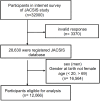Association of Regular Cervical Cancer Screening with Socioeconomic, COVID-19 Infection and Vaccine Status Among Japanese Population: Cohort Observational Study
- PMID: 38371520
- PMCID: PMC10874123
- DOI: 10.2147/IJGM.S453675
Association of Regular Cervical Cancer Screening with Socioeconomic, COVID-19 Infection and Vaccine Status Among Japanese Population: Cohort Observational Study
Abstract
Purpose: Among the Organisation for Economic Co-operation and Development countries, Japan has one of the lowest cervical cancer screening coverages. Cancer screening coverage has worsened due to the coronavirus disease of 2019 (COVID-19) pandemic. This study investigated the relationship between socioeconomic background, COVID-19 infection history and vaccine status, and regular cervical cancer screening (CCS) during the two years of the COVID-19 era in Japan.
Patients and methods: We used data from the Japan COVID-19 and Society Internet Survey, a nationwide, Internet-based, self-report cohort observational study conducted in 2022. The outcome variable was identified by asking whether the participants had undergone CCS within the last two years. Cervical cytology was performed in Japan by brushing the external cervical os. This study used multivariate log-binomial regression models to evaluate inequalities during regular checkups for CCS. Adjusted prevalence ratios (APRs) with 95% confidence intervals (CIs) were estimated to incorporate the socioeconomic background variables.
Results: Of the 12,066 participants, 5597 (46.4%) had undergone regular CCS for over two years. The prevalence ratio (PR) of patients who underwent CCS was 0.70 for those in their 20s and 0.78 for those in their 60s, compared to those in their 40s. Socioeconomic inequities were found in the following groups: unemployed/student, unmarried, high school graduate or lower, and household income below 4 million Yen. Our final multivariate analysis revealed that participants who were in their 20s or 60s, had a household income below 4 million Yen, were unmarried, had no annual health check-ups, and were unvaccinated with COVID-19 were at a higher risk of not undergoing CCS.
Conclusion: The relationship between socioeconomic inequality and CCS hesitancy is prevalent among younger participants. The CCS coverage in Japan during the COVID-19 pandemic year (2020-2022) was not low compared with the pre-pandemic era.
Keywords: cervical cancer screening; internet survey; screening hesitation; social inequality.
© 2024 Mitoma et al.
Conflict of interest statement
The authors declare no conflicts of interest in this work.
Figures
References
-
- OECE Stat Web Browser. Organization for Economic Co-operation and Development, Health care utilisation; 2021. Available from: https://stats.oecd.org/Index.aspx?QueryId=30159. Accessed 23, May 2023.
LinkOut - more resources
Full Text Sources
Research Materials


